Around five billion hours of videos are watched on YouTube every day, from online tutorials to shows, podcasts and up-and-coming actors and influencers who want to be seen and heard.
YouTube is the world’s second-largest search engine, and as with any search engine, SEO is essential to your success and visibility.
Word of warning, if you’re looking for a get-famous-quick scheme, this isn’t it. YouTube SEO is the same as any other SEO — it takes time to create an impact. Then, as time passes, you’ll start outranking your online competitors.
Now that you’ve read my SEO disclaimer, let’s dive into 12 SEO growth hacks to grow your YouTube channel.
1. Get Branded
Before you start using white hat SEO tips on your YouTube channel, you need to work on your YouTube channel’s branding. Here’s why: if your aim is for more views, online visibility, and awareness, you have to ensure that your online branding is cohesive, coherent, and concise.
So what is branding and why is it important?
Branding is the design, presentation, and the impact that you make on people who come in contact with you (virtually and in-person) and your content. It allows people to easily recognize your work without having to second guess or research.
One of the most influential and effective ways of branding is your logo. Your logo sets you apart from your competition and imposters. Adding your logo to your video and online content is one way to authenticate it. If you don’t have a creative team in-house, you can hire a graphic designer on Upwork or Fiverr.
For a more budget-friendly approach, you can use the following tools to create a logo in minutes:
If we break down branding further, using a distinct color scheme is also another form of branding. Color psychology is used strategically in marketing by top brands so that customers can associate them with the color — even if their logo isn’t visible.
YouTube Example: Perfect Dude

You’ll notice their PD logo on their videos, merch, and content along with the color Cyan (a form of blue and green) as their brand color. They also have a familiar visual aesthetic on their social media and website, so you know you’re looking at Perfect Dude content.

For more tips on getting started, try Neil Patel’s Guide on How to Grow Your Personal Brand Online.
2. Create Video Titles With Specific Keywords
A rookie mistake that new YouTubers make is creating videos without having a keyword in mind.
Once your video is published, it’s fighting against top-ranking content and keywords that push your video to the third page of Youtube search.
We all know that most people don’t even go on the second page of Google’s search engine. So what makes you think viewers are going to search on YouTube second page for your content?
Avoid being disappointed by creating video titles with keywords that rank and will increase your SEO visibility. Which brings me to the question, how do you choose the right keywords for SEO?
Firstly, a keyword is a word or phrase that’s used to identify content that people are looking for online. Secondly, there are three easy ways to find the right keywords.
How to Find The Right Keywords for YouTube Videos
1. Think Like Your Viewers
Once you know who your target audience is, you can find keywords that they’re most likely to use when searching for content. For example, if your niche is makeup, you know that your viewers are looking for the latest in beauty trends. When Fenty Beauty first launched MUA’s were using the keyword “Fenty Beauty” in video titles as much as possible as the keyword ranked high in the MUA industry.
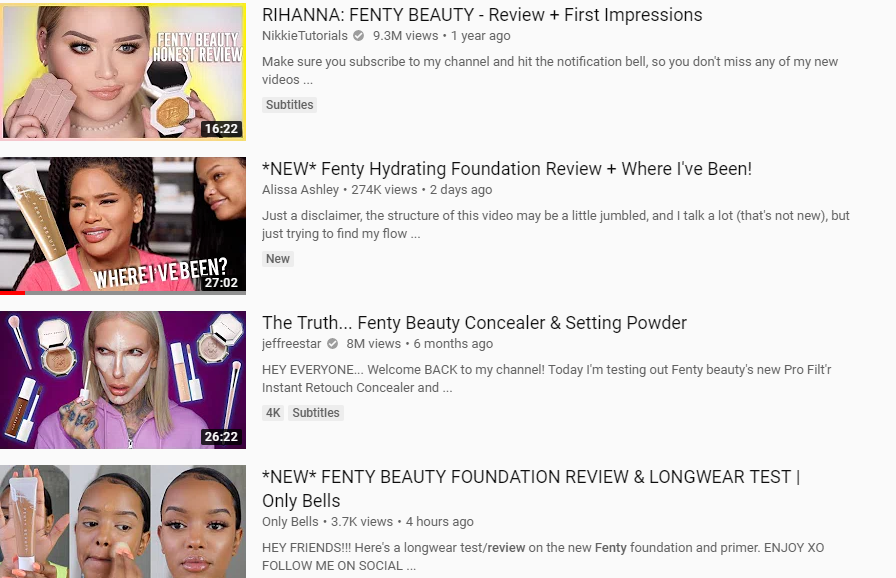
2. Use Google To Find Keywords
I’m serious; Google is a perfect place to find keywords and phrases you can use in your YouTube titles or tweak to make your own. Google is a good place to start if you’re entirely new to SEO research.
Google is also known for constantly changing its search algorithms while trying to deliver search results more relevant to what people want to find. So using it (along with some Google SEO reading materials) can help.
When you type in a topic or phrase, Google automatically shows answers or suggested searches. Once clicked on, the viewer gets relevant content like videos, books, and articles.

You can look at Google’s people also ask for possible topics, and titles for your videos that your target audience has shown interest in online.

3. Find Keywords with SEO Keyword Tools
As a writer and occasional YouTuber myself, I know that having the best content marketing and SEO keyword tools can give you an edge in your niche. I also know that sometimes we can’t pay over $200 each month for keyword tools, so I’ve listed the top four affordable and free SEO keyword tools you can start using for keyword research:
1.Related Keywords

This is an excellent Chrome or Firefox extension that allows you to see concise data on keywords you’re searching for or happen to click. It shows the CPC, keyword volume, and ranking, along with what other related keywords people are searching for online. You can easily download your results via Excel or click on the keyword of your choice to find out more information. It also works on platforms like Google search, Yahoo, YouTube, Esty, and more.
2. Google Adwords Keyword Planner

Trusted since the rise of SEO, Google Adwords Keyword Planner is a marketer’s go-to when creating ads or conducting keyword research for blog articles and videos. You’ll have to create a Google Ads account to access it, but it’ll be helpful in the future if you decide to run YouTube ad campaigns.
3. Moz Keyword Tool
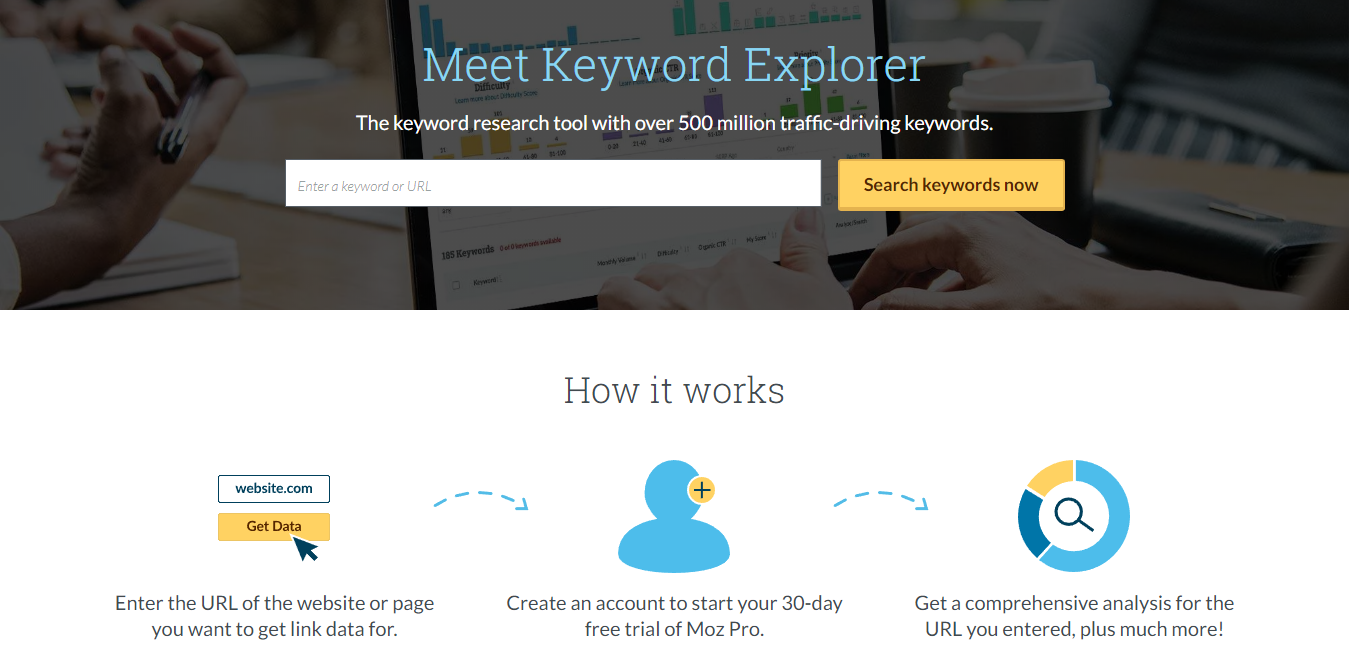
A tool created by Moz, the brainchild of the SEO wizards Rand Fishkin and Gillian Muessig, known for their actionable SEO tips and growth hacks. With its background, you know you’re in good hands with this tool. All you have to do is sign up, and you can start searching for keywords and phrases for your video title.
4.Answer the Public

This platform is a growing go-to SEO tool in SEO marketing circles. Answer the Public helps you to find (un)commonly asked questions by potential viewers and customers. You can use that information to create content that answers their concerns, positioning yourself as an expert or the influencer in your niche.
Pro Tip: Create a Seed Keywords List
Seed Keywords are terms that describe broad topics in a specific niche or category. For example, if you’re a YouTuber that specializes in social media marketing, your Seed Keywords could be:
Seed Keyword: Social Media
Potential YouTube videos could be (but are not limited to):
- Social Media Management Tools
- Social Media Apps for Marketing 2019
- Social Media Pros & Cons
4. Push for Video Shares
Foundation Inc. discovered that online users share content because they want to enrich the lives of those around them. That’s why they feel motivated to share valuable and entertaining content with their network on a day-to-day basis.
Take the initiative to ask your viewers in each video to share your videos with friends, co-workers, or family members who would appreciate or love your content. Make viewers feel that they’re sharing your video for their benefit rather than your own. It makes you feel, look, and seem more human and connected to your community.
YouTuber Example: Video Creator
Video Creator is another YouTube channel you should add to your list if you’re looking for ways to promote and outrank your competition.
In this video, he talks about where you should share your video once it’s published and how to use Google Analytics to find your best social media sources.
5. Have a Video Backlink Strategy
The same rules of SEO apply to your videos. Place your video’s backlinks in related topics on your website’s blog or guest post. Moz defines backlinks, also called “inbound links” or “incoming links,” as when one website links to another.
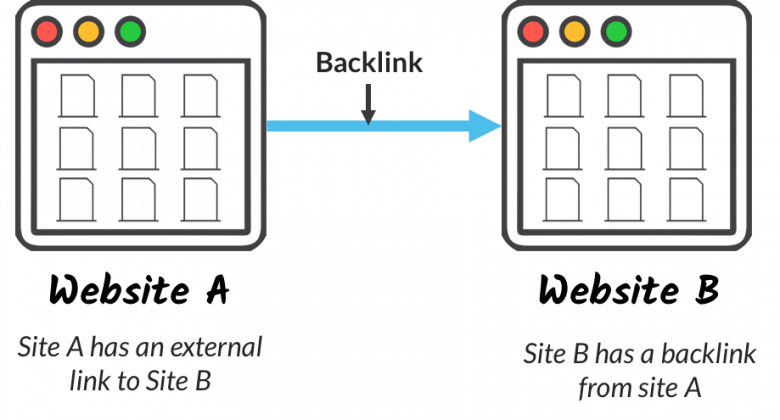
Backlinks allow you to increase traffic via off-site SEO; you can do this through link building. Your video’s backlink should be trustworthy, popular, and highly valued for it to drive traffic to your website.
Follow this guide on how to get more backlinks for a complete breakdown of this.
For more, check out Semalt’s What are the best practices to get quality backlinks for Youtube video?
6. Add Links to Your Video Description
Adding links to your YouTube channel isn’t necessary backlinking, but it is a form of link building!
YouTuber Example: Wishpond
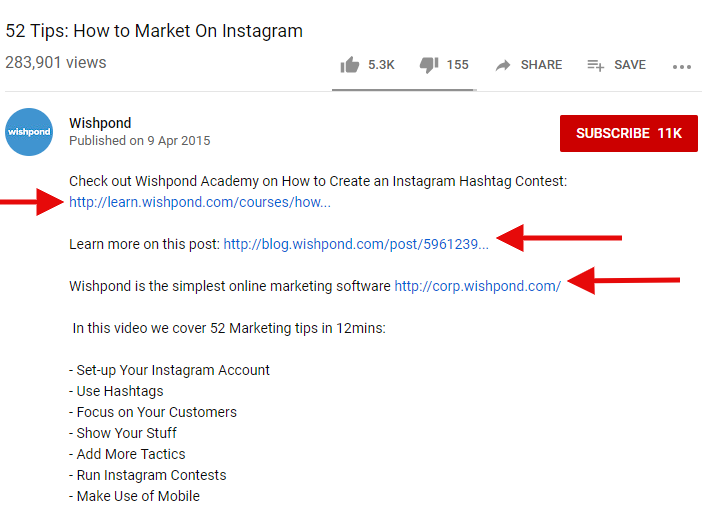
If you’re making a video that requires viewers to see a part two or additional information, you can place your link in the description. The same can be done to direct people to your products, services, website, and any current offers.
7. Embed Your YouTube Videos
Allow your website visitors to view, share, and comment on your videos. You can add videos to written posts like tutorials for visual learners.
Once your video is embedded, it’s seamlessly displayed on your website where viewers can press play, pause, or even share the video without leaving your page. Below is an image of an embedded video in one of our very own Wishpond blog posts.
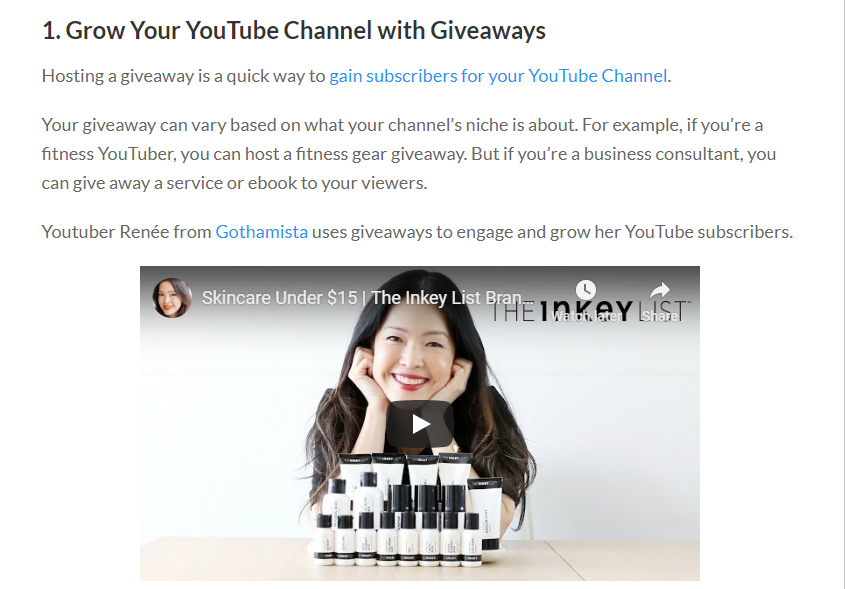
YouTuber Example: TeamYouTube Help
To do this yourself, you can read Canto’s step by step guide: The Fastest Way to Embed YouTube Video
8. Do Video Collaborations
Two YouTube channels are better than one! Expand your reach by doing a video collaboration and increase your SEO exposure. Co-host with a YouTuber with a complementary following to double your views and engagement.
Your co-host should either have the same number or more subscribers than you to support each other and improve your chances of popping up on the first page of YouTube’s search engine.
You never know what video will go viral. Take popular YouTuber Alisha Marie, when she decided to co-host her weird food video series with fellow foodie Shane Dawson.
YouTuber Example: Alisha Marie
Feel free to do a video collaboration with multiple YouTubers in one video or for an entire video series.
9. Use Short Video Titles
Keep your video titles to 50 characters or 7-10 words. The longer the title, the less of it viewers will see when they are searching for content on YouTube. Use long-tail keywords in your video titles.
Check out the top results for “best social media apps.” Notice what they all have in common: keywords and concise titles.
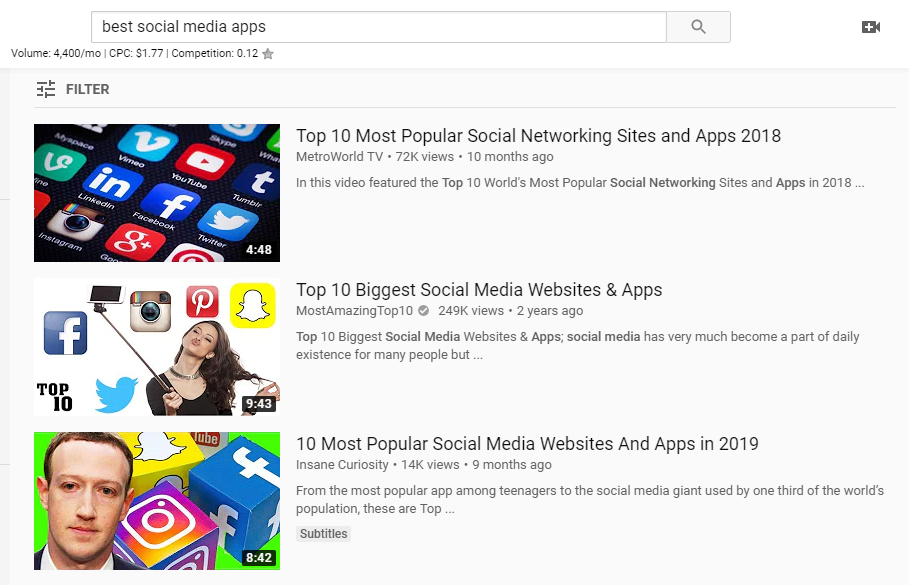
You can still use detailed video descriptions and titles so Google can find your video for relevant and highly-specific long-tail phrases. Just don’t go overboard, so your titles cut off.
10. Track Your YouTube Analytics
What do analytics have to do with SEO? Everything! You need to track your analytics to see if your SEO efforts are paying off on your YouTube channel, subscription, or website.
Keeping an eye on your metrics allows you to understand what’s working and what’s not. Where your videos are getting the most love, views and shares and which videos are performing better than others.
YouTube analytics isn’t as daunting as it sounds. Earlier we spoke about VidIQ, but here are two free tools you can use to monitor your videos: YouTube Studio Dashboard and Google Analytics
Here are 12 YouTube analytics every YouTuber should know:
- Watch Time
- Impressions Click-Through Rate
- Card Click-Through-Rate
- Playlist Engagement
- Unique Viewers
- Traffic Sources
- Subscriber Growth
For more here are the 12 Youtube Analytics Every YouTuber Should Know
11. Use Keywords in Your Video File Name.
Yes, it does make a difference. For example, if you upload your video, change your video’s default name from “10000412556.mp4.” to “Marketing.growth.hacks.mp4”. Google will automatically focus on the keywords in your video’s title. As simple as it seems, this can help to boost your video ranking dramatically.
12. Grow Your Youtube Channel by Uploading Your Videos on Facebook
Uploading your YouTube videos on other video platforms like Facebook, IGTV or Vimeo can help you to reach a broader audience that could be interested in your content.
Though most marketers still say they prefer YouTube over Facebook (87% vs. 68%) when combined for video and marketing efforts, the results speak for themselves. You can place a link to subscribe in your description or caption so you can grab some subscribers along the way.
You can also try these 4 Simple Ways to Use Videos on Facebook to help boost your engagement.
Bonus:Use VidIQ
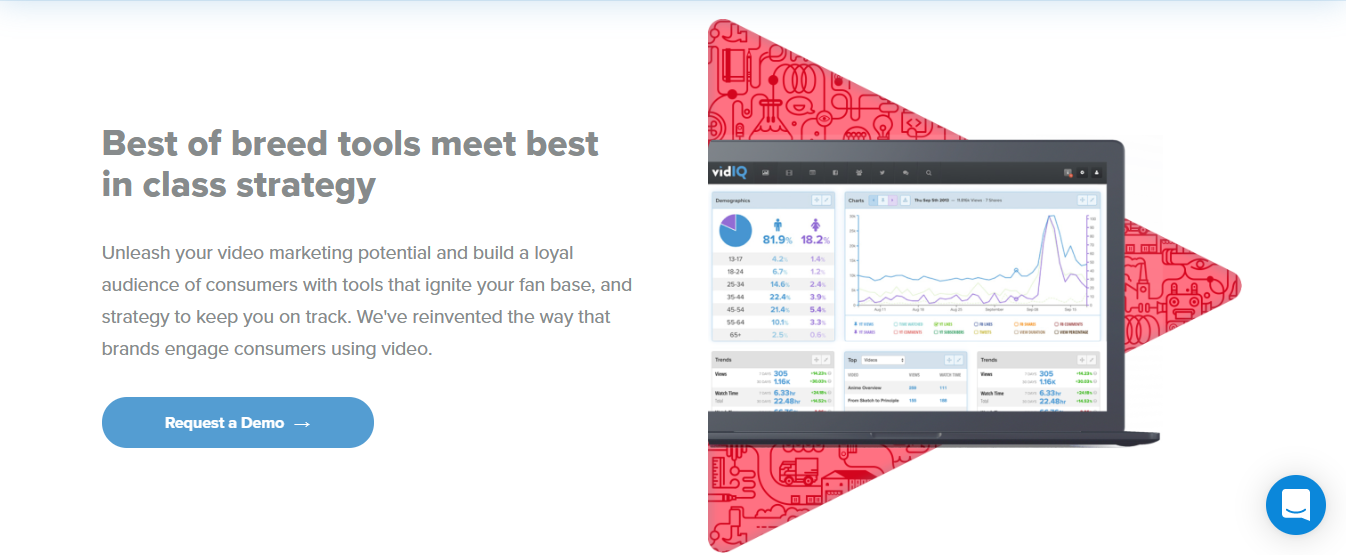
Vid IQ is one of the most used YouTube analytics tools to help you to reach your goals and learn what you need to improve your channel.
Learn how you can drive traffic from your YouTube videos to your landing page and website, an individual publisher to manage your own (or multiple) YouTube channels. You’ll also get YouTube SEO tips, suggested titles, and detailed descriptions to make your videos more engaging.
YouTuber Example: Think Media
Check out this quick overview by Think Media, one YouTube’s best channel for anyone learning how to master YouTube, video, and influencer marketing.
A free account is available, but if you’re serious about growing your YouTube Channel then invest in your channel and go pro to access added features to drive more subscribers to your channel.
10 Tools You Need To Grow Your YouTube Channel
Not only am I going to show you 18 best ways to grow your Youtube channel, but I’ll also leave you with a list of the top 10 tools you need to grow your YouTube channel.
1.Canva: Use Canva to create free YouTube thumbnails with free templates and designs easily.
2.Keyword Tool: Use
Keyword Tool to help you find specific keywords that rank on Google and Youtube so you can optimize your content for SEO.
3. VidIQ: The go-to YouTube analytic tools to help you to reach your goals and learn what you need to improve your channel.
4. TubeBuddy:: This is a YouTuber’s best friend, it helps you to streamline your daily workflow on YouTube as well as editing and managing your content in bulk.
5. Social Blade: Social Blade gives access to data-driven YouTube ranking and analytics for not just for your YouTube channel but others as well.
6. Bitly: You’ll be using this tool a lot when it comes to sharing your YouTube video links. Bitly helps you to take a long URL and turn it into a short and simple link.
7. Google Analytics:: YouTube Analytics and Google Analytics make a powerful duo when it comes to tracking your YouTube and website metrics to see the results of all your promotion and actions.
9. Camtasia: Use this app for professional screen and video editing when you need it the most.
10. Social Media Management Tools: Use social media management tools like Buffer or Hootsuite to better manage and promote your YouTube channel and videos on social media.
The Rundown
Growing your YouTube channel isn’t a sprint, it’s a marathon. Each time you upload, engage, or share your content, you have to make sure you’re doing it in a way that optimizes your video content’s SEO.
As you continue best practices, your channel will not only grow but withstand the test of time.
Need help with promoting your YouTube channel?
Book a free call to learn how our team of marketing experts can help you promote and drive traffic to your video today.
Related Articles
- 12 Youtube Analytics Every YouTuber Should Know
- 12 Tips for Using YouTube for Your Small Business
- 18 Powerful Ways to Grow Your YouTube Channel
- Video Marketing: A 3-Step Introduction to Success with YouTube

